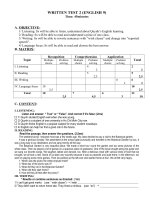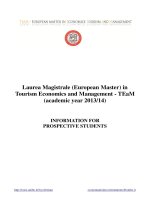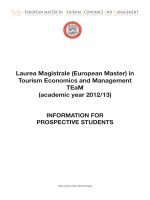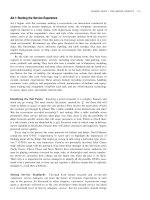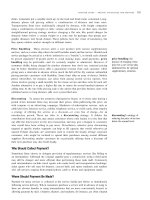Consumer behavior and marketing strategy 12e hawkins motherbaugh chapter 12
Bạn đang xem bản rút gọn của tài liệu. Xem và tải ngay bản đầy đủ của tài liệu tại đây (2.13 MB, 28 trang )
CHAPTER
12
Self-Concept
and
Lifestyle
McGraw-Hill/Irwin
Copyright © 2013 by The McGraw-Hill Companies, Inc. All rights reserved.
PART III: INTERNAL INFLUENCES
12-2
Learning Objectives
L0
1
L0
2
Describe self-concept, how it is measured, and how it
is used to position products
Define lifestyle and its relationship to the self-concept
and to psychographics
L0
3
Explain specific lifestyle typologies and summarize
those for luxury sports cars and technology
L0
4
Explain general lifestyle typologies and summarize
those for VALSTM and PRIZM®
L0
5
Discuss international lifestyles and one existing
segmentation scheme
12-3
Consumer Behavior In The News…
Does power and status matter that much? You be the
judge:
Do you think consumers would pay $300 for a
high-status toaster when they could buy a
functionally equivalent toaster for $30?
What might explain this?
Source: A. Galinksy and D. Rucker, “’Powerless’ Consumers Spend More,” Advertising Age, September 22, 2008, p. 50.
12-4
Consumer Behavior In The News…
Does power and status matter that much?
If you said YES you are correct!
Explanation: Actual vs. Ideal Self-Concept.
Consumers who feel a lack of power/status in
their self concepts fill void via purchase of
power/status brands.
Source: A. Galinksy and D. Rucker, “’Powerless’ Consumers Spend More,” Advertising Age, September 22, 2008, p. 50.
12-5
Self-Concept
12-6
Video Application
The following Video Clip demonstrates
Dove’s campaign designed to bridge the
gap between the consumer’s “actual”
and “ideal” self concept!
12-7
12-8
12-8
Self-Concept
Independent/Interdependent Self-Concepts
Individuals with an
independent self-concept
tend to be
•
•
•
•
•
Individualistic
Egocentric
Autonomous
Self-Reliant, and
Self-Contained
Individuals with an
interdependent selfconcept tend to be
•
•
•
•
•
Obedient
Sociocentric
Holistic
Connected, and
Relation oriented
12-9
Self-Concept
Possessions and the Extended Self
The extended self consists of the self plus possessions.
People tend to define
themselves in part by their
possessions.
A peak experience is an
experience that surpasses the
usual level of intensity,
meaningfulness and richness
and produces feelings of joy and
self-fulfillment.
Tattoos can become a part of one’s
extended self
12-10
Self-Concept
12-11
Self-Concept
The Relationship Between Self-Concept and Brand Image Influence
12-12
The Nature of Lifestyle
Lifestyle is basically how a person lives. It is how one
enacts his or her self-concept.
Influences all aspects of one’s consumption behavior.
Is determined by the person’s past experiences, innate
characteristics, and current situation.
Mountain Dew taps into the Tarp Surfing Lifestyle
YouTube Spotlight
12-13
The Nature of Lifestyle
Lifestyle and the Consumer Process
12-14
The Nature of Lifestyle
Measurement of Lifestyle
Attempts to develop quantitative measures of lifestyle were initially
referred to as psychographics. Measures include:
Attitudes
Evaluative statements about other people, places, ideas,
products, etc.
Values
Widely held beliefs about what is acceptable or desirable
Activities and
Interests
Nonoccupational behaviors to which consumers devote time and
effort, such as hobbies, sports, public service, and church
Demographics
Age, education, income, occupation, family structure, ethnic
background
Media patterns
The specific media the consumer utilize
Usage rates
Measurements of consumption within a specified product
category; often consumers are categorized as heavy, medium,
light, or nonusers
12-15
The Nature of Lifestyle
Two specific lifestyle schemes:
1. Luxury Sports Cars
2. Technology
12-16
The Nature of Lifestyle
Porsche Consumer Segments
Top Guns (27%)
Ambitious and driven, this group values power and
control and expects to be noticed.
Elitists (24%)
These old-family-money “blue-bloods” don’t see a
car as an extension of their personality. Cars are
cars no matter what the price tag.
Proud Patrons 23%)
This group purchases a car to satisfy themselves,
not to impress others. A car is a reward for their
hard work.
Bon Vivants (17%)
These thrill seekers and “jet-setters” see cars as
enhancing their already existing lives.
Fantasists (9%)
This group uses their car as an escape, not as a
means to impress others. In fact, they feel a bit of
guilt for owning a Porsche.
12-17
The Nature of Lifestyle
Technology Segments
W izards 31%
Journey men 13%
Technology
Segments
A pprentices 31%
Nov ices 25%
12-18
The Nature of Lifestyle
Three general lifestyle schemes:
1. The VALSTM System
2. The PRIZM® System
3. Roper Starch Global Lifestyles
12-19
The VALSTM System
VALS provides a systematic
classification of U.S. adults
into eight distinct consumer
segments.
VALS is based on enduring
psychological
characteristics that correlate
with purchase patterns.
12-20
The VALSTM System
Three Primary Consumer Motivations:
1. Ideals Motivation
2. Achievement Motivation
3. Self-Expression Motivation
12-21
The VALSTM System
12-22
Geo-Lifestyle Analysis (PRIZM®)
The underlying logic:1
People with similar cultural backgrounds, means and
perspectives naturally gravitate toward one another.
They choose to live amongst their peers in
neighborhoods offering …compatible lifestyles.
They exhibit shared patterns of consumer behavior
toward products, services, media and promotions.
1Nielsen Claritas.
12-23
Geo-Lifestyle Analysis (PRIZM)
PRIZM Social and Lifestage Groups
PRIZM organizes its 66 individual segments into social and
lifestage groups.
Four social groupings are based on “urbaniticity.”
Urban
Major cities with high population density
Suburban
Moderately dens “suburban” areas surrounding
metropolitan area
Second City
Smaller, less densely populated cities or satellites to
major cities
Town & Rural
Low-density towns and rural communities
12-24
Geo-Lifestyle Analysis (PRIZM)
PRIZM Social and Lifestage Groups
The lifestage groups are based on age and the presence of
children.
The three major lifestage groups are:
Younger Years
Singles and couples under 35 years of age with no
children, or middle aged without children at home
Family Life
Households with children living at home
Mature Years
Singles and couples; age 55 yrs and older, or 45-64
without children at home
12-25
